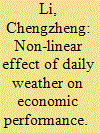| Srl | Item |
| 1 |
ID:
182737


|
|
|
|
|
| Summary/Abstract |
Does extreme heat have causal effects on exports? If so, how do the effects evolve? This paper exploits monthly fluctuations in the number of extremely hot days within a city to identify their effects on firm-level exports in that city. We find robust evidence that hot temperatures have persistent adverse effects on firm-level exports. Specifically, export losses gradually arise following a heat shock, beginning from an undetectable impact and eventually accumulating to a large and significant impact. An additional >30 °C day in a month could generate cumulative losses up to 0.83% of a firm's annual exports twenty-four months later. The negative effects of extreme heat are mainly through its adverse impacts on the firm's investment, capital, and production output. Capital-intensive sectors and FDI-related enterprises are among the most affected by high temperatures. Our findings support the “no-recovery” hypothesis after weather extremes and have implications for future climate change policies.
|
|
|
|
|
|
|
|
|
|
|
|
|
|
|
|
| 2 |
ID:
182738


|
|
|
|
|
| Summary/Abstract |
Does extreme heat have causal effects on exports? If so, how do the effects evolve? This paper exploits monthly fluctuations in the number of extremely hot days within a city to identify their effects on firm-level exports in that city. We find robust evidence that hot temperatures have persistent adverse effects on firm-level exports. Specifically, export losses gradually arise following a heat shock, beginning from an undetectable impact and eventually accumulating to a large and significant impact. An additional >30 °C day in a month could generate cumulative losses up to 0.83% of a firm's annual exports twenty-four months later. The negative effects of extreme heat are mainly through its adverse impacts on the firm's investment, capital, and production output. Capital-intensive sectors and FDI-related enterprises are among the most affected by high temperatures. Our findings support the “no-recovery” hypothesis after weather extremes and have implications for future climate change policies.
|
|
|
|
|
|
|
|
|
|
|
|
|
|
|
|
| 3 |
ID:
182776


|
|
|
|
|
| Summary/Abstract |
This paper thoroughly examines the impacts of daily weather on the aggregate economic outcomes in China and identifies the underlying channels. Using within-county variations in daily weather between 1996 and 2012, we find that daily temperature and precipitation have non-linear effects on county-level economic outcomes. An additional day with an average temperature above 20 °C reduces county-level GDP by 0.05% to 0.08%, and the detrimental effects tend to intensify when the temperature rises. The precipitation does not have robust effects on county-level GDP. By examining the effects of daily weather on primary, secondary, and tertiary industries, we find that the primary industry is the main channel of the negative impacts of high temperatures. Heavy precipitation is inclined to harm agricultural output, especially grains and oil crop yields. Besides, we discover heterogeneous responses to weather extremes across counties and find suggestive evidence of adaptation.
|
|
|
|
|
|
|
|
|
|
|
|
|
|
|
|